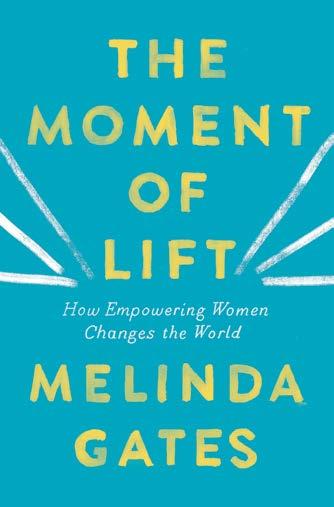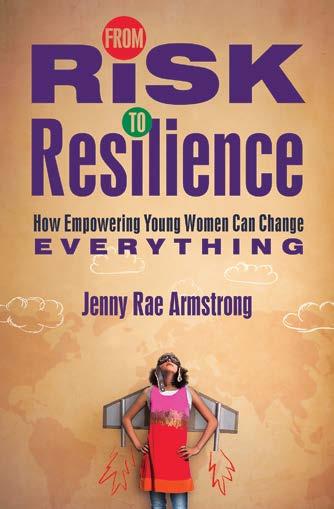
6 minute read
Battling gender inequity to benefit all
Battling gender inequity to benefit all
By Joyce Lehman
THE MOMENT OF LIFT: How Empowering Women Changes the World By Melinda Gates (Flatiron Books, 273 pp., US$26.99) FROM RISK TO RESILIENCE: How Empowering Young Women Can Change Everything By Jenny Rae Armstrong (Herald Press, 2019, 206 pp., US$29.99)
Many international organizations design projects using a “gender lens” to intentionally benefit women over other groups. Experience has shown that empowering women strengthens the family, the community and the world. The life journey and ‘lens’ of the authors are very different.
Readers may identify with one more than the other. But in the end, their final thoughts as to how this universal inequity should be addressed are remarkably similar. In The Moment of Lift, Melinda Gates offers a glimpse into her life before meeting her future husband.
A whip-smart student at an all-girl Catholic high school in Dallas, she used her Duke University computer science degree to land a job at Microsoft, a smallish Seattle software company. Years later in 2000, she and her husband created the Bill & Melinda Gates Foundation.
In the years since, she has increasingly become an international advocate for maternal and child health. The Foundation collects voluminous data on all its work, but for her, the best way to learn is by listening. Gates takes us with her as she hears

the voices of women, many of whom are in extreme circumstances of poverty and abuse.
For the daughter of a stay-at-home mom and an aerospace engineer dad who worked on the Apollo program, space launches were big family moments. They joined other families to watch the drama, barely able to breath during the countdown to … Liftoff! Gates writes that for
humanity, as with space shuttles, moments of lift happen when “the forces that push us up overpower the forces that pull us down.”
The forces that pull humanity down create and sustain an abusive culture, one that singles out, excludes or diminishes a group. Such cultures are always less productive as energy is wasted on keeping people down rather than lifting them up. Gender discrimination is encoded in law in nearly every country in the world, Gates writes, including the US. She believes inequity increases when religions are dominated by men who distort the Bible, the Koran, and other sacred texts to serve their own purposes.
These potent, millennia-old forces can only be overpowered when women gather together. Telling stories and sharing their grief creates a new culture built by their voices and values. Leymah Gbowee launched a women’s peace movement in Liberia that ultimately sent the President to prison for war crimes. Sex workers in India set up a speed dial network so others could come to their rescue when clients or police became violent. The stories are heart-breaking and uplifting. “Every man who’s a bully is afraid of a group of women,” she writes. Empowerment starts with getting together. That incites the courage to let women be seen and to ask for what they want or need, especially when no one wants them to have it.
Jenny Rae Armstrong is the daughter of missionaries in Liberia who left the country during a military coup when she was 8 years old. She now pastors a Wesleyan Church in Wisconsin. She calls for people of faith to “search the face of God for the sake of the world’s most endangered species, the human girl.” In From Risk to Resilience, she uses data to support her thesis that the most vulnerable period of a girl’s life is between the ages of 12 and 21. This is when they are most likely to be at risk of rape, hunger, slavery, sexism and poverty. Armstrong gives examples of young women in dire circumstances globally. However, her narrative is mostly about girls in our world and the pressures they face in our time.
Each chapter expands on an issue and its effect on girls: education, commodification, violence, early partnering, early childbearing, and conflict zones. The chapters follow a pattern. Statistics demonstrate the scope of the problem. Examples drawn from her own experience and those of women who came before make it personal. She states her hypothesis of the source of the problem and then looks to Scripture for guidance on the solution.
The look to Scripture seems tortured, as though Armstrong is checking the pastor-writer box. Her graphic retelling of Old Testament stories does little more than confirm that women and girls were equally at risk in Biblical times. She is much more direct when calling out the “clobber passages” of the New Testament. These passages that exhort women to be submissive are too often used to “keep women in their place.” True, but still not a solution.

Like Gates, Armstrong believes church leaders are part of the problem and makes a strong case. Girls learn early on that their social power is not about intelligence or kindness but about appearance and sexuality. She blames the media for this commodification but also faults the underlying principle behind the message.
Foremost is the subliminal acknowledgment that women exist for the benefit of men. This will not change as long as the decision-makers in the media and advertising companies are mostly men.
She goes a step further to say that church messages about sexuality are similar. Women should dress for the male gaze; the responsibility for managing male sexuality is on their shoulders. The modesty police blame a woman’s clothing choice for the rape. And how many women, she asks, have stayed in abusive relationships because a pastor quoted a submission passage?
Armstrong states correctly that today, Honduras is ranked as the most dangerous country in the world in which to be female. Yet, so-called Christian leaders support turning away those who seek refuge when Christ’s teaching is all about caring for the most vulnerable. Though ardently antiabortion, she is disturbed by the frequent conflation of abortion and contraception.
She believes the debate then has more to do with policing women’s sexuality than with saving babies. Choosing life, she writes, is about more than opposing abortion. That part of the equation is rarely mentioned.
In the epilogue, Gates confesses that for her, gender equality is a milestone, not the summit. People can be equal but isolated. The goal is to be connected, to belong without stigma or shame, to see each in the other, to share joys and burdens, to love. Love is what lifts us up.
Armstrong calls on people of faith to gather together and fight for Shalom for girls, for a place where “things are rightly ordered and all can flourish.” We should do this because we bear the name of Christ. In his kingdom there is no regard for gender, ethnicity, nationality or any difference at all.
The authors have their own perspective. But in the end, the vision of each is consistent with the core lessons of which Christ spoke so much. Love One Another. Peace be upon Us. ◆
Joyce Lehman is a member of MEDA’s board of directors. She is currently a technical advisor on financial inclusion projects. Previously, she worked as a program officer with the Bill & Melinda Gates Foundation.






